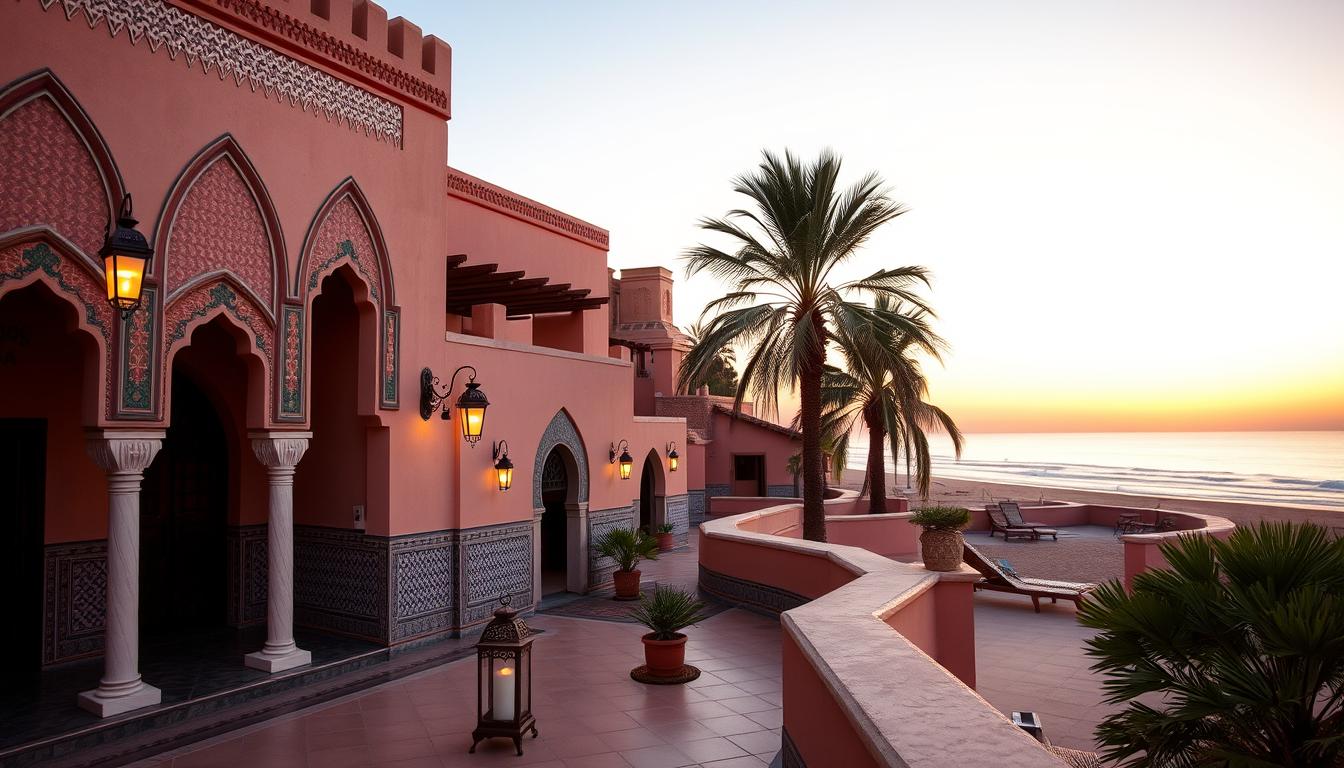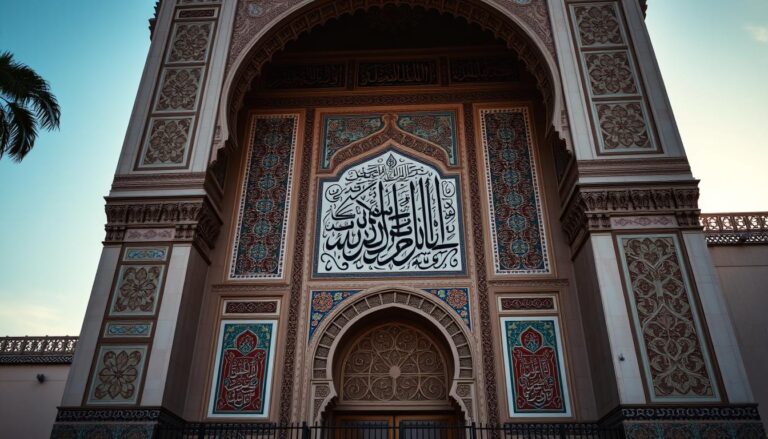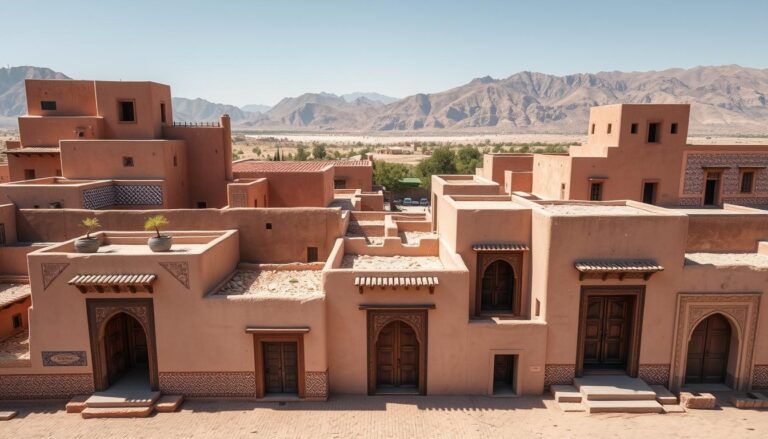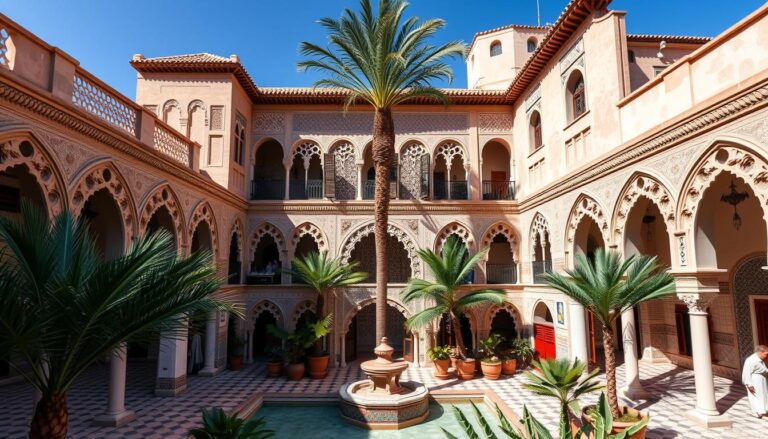Imagine if walls could talk. They might share Morocco’s amazing architectural story. Here, ancient Amazigh traditions, Islamic art, and European touches blend beautifully. This creates a stunning coastal scene.
From the detailed Zellige tilework to the fancy Mashrabiya woodcarvings, Coastal Moroccan architecture shows the country’s rich culture. It’s a mix of different styles that make it truly unique.
Key Takeaways
- Coastal Moroccan architecture blends Amazigh, Islamic, and European influences, resulting in a unique and enchanting architectural style.
- The region’s proximity to the Mediterranean and Atlantic oceans has shaped the use of materials, construction techniques, and decorative elements.
- Iconic features of Coastal Moroccan architecture include Zellige tilework, Mashrabiya woodwork, Muqarnas carvings, and Stucco artistry.
- Coastal cities like Casablanca, Rabat, and Asilah showcase the diverse architectural legacy of Morocco’s past.
- Modern Coastal Moroccan architecture seeks to balance traditional design with contemporary sustainability practices.
Introduction to Moroccan Architecture
Moroccan architecture is a mix of many cultures. It includes the ancient Amazigh (Berber) traditions, Islamic, and French colonial styles. This blend has made Morocco’s buildings unique and fascinating to the world.
Morocco’s Architectural Heritage
Morocco’s buildings show a wide range of styles. You can find ancient Roman sites, historic Islamic architecture, and 20th-century French colonial buildings. The Moorish or western Islamic architecture stands out, mixing Amazigh culture, pre-Islamic Spain, and the Islamic Middle East.
Influence of Amazigh, Islamic, and Colonial Traditions
Islam’s arrival in the 8th century changed Moroccan architecture. It influenced the types of buildings and their design values. The Berber Empires of the Almoravids and Almohads in the 11th-13th centuries also played a big role. They set many architectural forms and motifs.
The French colonial period in the 20th century also had a big impact. It brought European-style neighborhoods and urban planning to Morocco.
“Moroccan architecture is a testament to the enduring power of cultural exchange and the ability of different traditions to coexist and flourish within a single built environment.”
Coastal Moroccan Architecture: A Unique Blend
The architecture along Morocco’s coast is a mix of different cultures. It’s shaped by the Mediterranean and Atlantic. This blend creates a beautiful and unique look.
Influence of the Mediterranean and Atlantic
The Mediterranean influences show in the Zellige tilework. These tiles have intricate patterns on walls, floors, and ceilings. The Atlantic influences are seen in the Mashrabiya woodwork. These are the latticed windows that let in air and keep things private.
The Muqarnas carvings and Stucco artistry add to the beauty. They are found inside and outside buildings. They show the area’s rich art history, mixing different cultures into one style.
“Coastal Moroccan architecture is a captivating symphony of cultural influences, where the Mediterranean and Atlantic meet to create a harmonious and visually striking aesthetic.”
Iconic Coastal Moroccan Landmarks
Coastal Morocco boasts some of the country’s most famous landmarks. The Hassan II Mosque in Casablanca and the Kasbah of Oudayas in Rabat stand out. They are architectural wonders that attract visitors from around the world.
The Hassan II Mosque in Casablanca
Finished in 1993, the Hassan II Mosque is the largest in the world and the second-largest in Africa. It combines traditional Moorish design with modern touches. The mosque’s 200-meter-high minaret is a striking feature seen across the city.
The Kasbah of Oudayas in Rabat
The Kasbah of Oudayas in Rabat is a historic area that shows off coastal Moroccan architecture. Its whitewashed buildings and narrow streets are close to the Atlantic Ocean. It gives a peek into Morocco’s architectural past.
These landmarks, along with others, draw visitors to Morocco’s coast. They highlight the country’s artistic and cultural traditions.
“Morocco is a rich tapestry of architectural styles, each reflecting the country’s diverse cultural influences and historical legacies.” – Architectural Digest
Coastal Moroccan architecture in Moroccan Architecture
Coastal Moroccan architecture is a special part of Moroccan design. It combines Amazigh, Islamic, and colonial styles. The Mediterranean and Atlantic have added unique touches to coastal buildings.
Coastal buildings often use sea-inspired designs. You’ll see curved roofs and weathered wood and stone. This mix of styles creates a beautiful and practical look.
The coast of Morocco is a place where cultures meet. European and African styles blend together. The Hassan II Mosque in Casablanca is a great example, mixing old Moroccan designs with new tech. The Kasbah of Oudayas in Rabat also shows this mix, with its Amazigh, Islamic, and colonial elements.
“Moroccan architecture reflects a diverse architectural heritage, including ancient Roman sites, historic Islamic architecture, local vernacular architecture, 20th-century French colonial architecture, and modern architecture.”
Today, Moroccan architecture is still growing, with the coast playing a big role. Architects are finding new ways to use old designs and add modern touches. They also focus on making buildings sustainable while keeping the coastal look.
Traditional Coastal Moroccan Architecture
Along Morocco’s stunning coastlines, architecture has changed over time. It combines Amazigh, Islamic, and colonial styles. At its core are the riads, traditional courtyard houses. They offer peace in the busy city.
Riads and Courtyards
Moroccan homes often have a central wast ad-dar, or large courtyard. This courtyard is the heart of the home. It has calm fountains and beautiful zellige tilework, showing the owner’s wealth.
The oldest riads come from the Marinid (13th-15th centuries) and Saadi (16th-early 17th centuries) times. They show the lasting beauty of Moroccan architecture. Now, many are riads, or boutique hotels, for today’s travelers.
Mashrabiya Woodwork and Zellige Tilework
Mashrabiya woodwork is a key part of Moroccan architecture. These carved wooden screens offer privacy and let in air. This is important in Morocco’s hot climate.
The zellige tilework in Moroccan homes is also special. It’s made of colorful tiles that add beauty and history to the buildings.
“The central patio/courtyard of traditional Moroccan houses, the wast ad-dar, serves as the focal point of the house indicating the wealth and status of its owners, rather than the external facade.”
Modern Coastal Moroccan Architecture
Modern coastal Moroccan architecture is a blend of old and new. Architects like Driss Kettani mix traditional styles with modern needs. They also use sustainable practices.
This approach aims to honor the past while looking to the future. The Grand Stade Hassan II stadium in Morocco is a big example. It will hold 115,000 fans for the 2030 World Cup.
In cities like Casablanca, modern architecture is making a big impact. Maison Edouard François is building towers with vertical gardens. These gardens use flowering vines, combining old and new.
Architects across Morocco are planning cities and buildings that are both sustainable and respectful of local traditions. They use local materials and traditional techniques in buildings like l’Ecole Supérieure de Technologie de Guelmim and Taroudant University.
This movement shows Morocco’s ability to move forward while keeping its architectural heritage alive. Moroccan architects are creating a unique and striking environment. It appeals to both locals and people from around the world.
“Moroccan architects are focusing on cohesive cityscape planning and sustainable developments respecting local traditions.”
Sustainable Practices in Coastal Moroccan Architecture
In coastal Moroccan architecture, there’s a big push for sustainable practices. Architects like Driss Kettani and Salima Naji are using old building techniques in new ways. They draw inspiration from the past to make buildings that are good for the planet.
These architects know the local environment well. They design buildings that fit right in and are kind to the earth. They make sure the buildings work with the local climate and geography.
Studies show that natural ventilation can cut cooling costs by half. Mud brick homes in Morocco use 30% less energy for heating and cooling. This is because the thick walls made from local materials keep the inside temperature steady.
“Sustainable coastal Moroccan architecture is not just about aesthetics, but about honoring the delicate balance between human habitation and the natural environment.”
By sticking to vernacular architecture, designers make buildings that are both beautiful and practical. They match the local climate and geography. This way, they show that old building ways can still be useful today.
Places like the Hassan II Mosque in Casablanca show off sustainable design. Architects are mixing old and new to make buildings that are good for the future. They aim for a world where coastal communities live in harmony with nature.
Conclusion
Coastal Moroccan architecture is a mix of many cultures, histories, and environments. It includes famous spots like the Hassan II Mosque and the Kasbah of Oudayas. These buildings show how architecture has changed over time, creating a special look.
As Morocco grows, architects try to keep old styles while adding new ones. They also focus on being green. This way, coastal Moroccan architecture stays fresh and shows off the country’s culture.
The Hassan II Mosque in Casablanca is a great example of this mix. It shows Morocco’s commitment to its past and future. Its design blends old and new, showing how coastal Moroccan architecture can be both traditional and modern.
Source Links
- Moroccan architecture
- An Exploration of Modern Moroccan Architecture – The Yale Globalist
- 24 Examples of Amazing Moroccan Architecture – Journey Beyond Travel
- STUDY TRIPS ABROAD – Exploring Moroccan Design
- ▷ Art and architecture in Morocco | Chic Morocco
- Morocco’s Rich Architectural History
- Majestic Moroccan Architecture In 10 Buildings
- Learning from the ancients, modern Moroccan architecture forges new identity | Africanews
- Architecture in Morocco | Morocco.com
- Discover Morocco – Historic landmarks | Moroccan National Tourist Office
- historical monuments in morocco
- Iconic Sites and Moroccan Landmarks – Demand Africa
- Moroccan architecture and design | Dezeen magazine
- Exploring the Richness of Moroccan Architecture – Cindrebay
- Historic house architecture in Morocco
- Discover the Marvels of Moroccan Architecture
- The Timeless Design of Moroccan Homes
- Sustainable Traditional Architecture of Egypt and Morocco
- Exploring the Timeless Beauty of Moroccan Architecture | African Sahara
- Hassan II Mosque: A True Marvel of Moroccan Architecture
- Discovering the Beautiful Architecture of Hassan II Mosque

The Editorial Team is a passionate group of Morocco enthusiasts dedicated to sharing the beauty, culture, and wonders of this captivating country. With diverse backgrounds and a deep love for travel, we strive to bring you engaging and informative content that inspires your Moroccan adventures. From uncovering hidden gems and sharing local insights to exploring mouthwatering cuisine and showcasing the vibrant lifestyle, our team is committed to providing you with valuable resources and exciting stories that enhance your exploration of Morocco. Join us on this journey as we celebrate the rich heritage and unforgettable experiences that make Morocco truly special.







